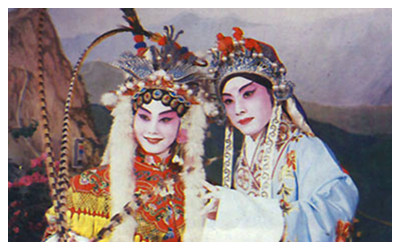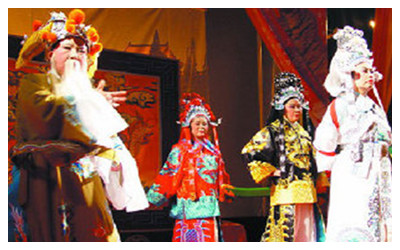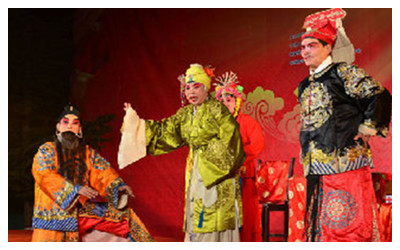Skype: neodalle-travel
Tel: +86 135 7447 2266
E-mail: sales@visitaroundchina.com
 Shanxi Drama or Shanxi Opera,also called Jin Opera, is one of the four Bangzi operas in Shanxi Province. Bangzi opera is a group of operas generally distinguished by their use of wooden clappers for rhythm and by a more energetic singing style.
Shanxi Drama or Shanxi Opera,also called Jin Opera, is one of the four Bangzi operas in Shanxi Province. Bangzi opera is a group of operas generally distinguished by their use of wooden clappers for rhythm and by a more energetic singing style.
"Jin" is the shortened form for "Shanxi." Because it originated in the central area of Shanxi, it is also called Zhonglu (literally Central) Bangzi, now popular in the central and northern areas of Shanxi, Shaanxi, Inner Mongolia and Hebei provinces.
Jin Opera was formed in the early Qing Dynasty (1644-1911), and then spread to the surrounding areas as well as parts of Shaanxi, Inner Mongolia and Hebei. It was popularized during the late Qing Dynasty with the help of the then-ubiquitous Shanxi merchants who were active across parts of China.
Jin Opera has more than 200 popular plays. The accompanying orchestra is traditionally made up of 9 people in two groups -- one plays the huhu (a stringed instrument), a two-string instrument, a Chinese trichord and a four-string instrument, the other plays clappers, cymbals, small gongs, ma gongs, and bangzi.
As the representative opera of Shanxi, Jin Opera is valuable for research on local operas, music, folk customs, and history of Shanxi.
Shanxi Opera has a long history and is considered one of the original Chinese dramas, with its own unique cultural charateristics, for which it is accorded a certain honor. The earliest Shanxi drama dates back to the Han Dynasty (206BC-220) and was referred to as “baixi” (hundred dramas) for its dances and acrobatics. By the Song Dynasty (AD420-479), it had reached quite a high level.Shanxi has more than 390 drama types, 54 of them its own particular type, and these days, thanks to the gradually developing culture and innovation, has the new vigor, with many famous artists In May of this year, 44 Shanxi performers won the Plum Blossom Prize, China’s top dramatic performance award, putting the province in the No.1 slot nationwide.

Shanxi has a form of Bangzi operas, a kind of local opera accompanied by wooden clappers, including Puzhou, Zhonglu, Beilu, and Shangdang, which are outstanding representatives of Bangzi opera and of the historical and cultural values of the Chinese dramatic arts mixed with folk customs.
Zhonglu Bangzi, also known as Jin opera or Shanxi Bangzi, is popular in the middle part of the province, especially in the cities of Taiyuan and Jinzhong, and is known for its rhythm and clear spoken parts.
Beilu, which developed in the mid-16th century, is popular in northern Shanxi and the Inner Mongolia autonomous region, where it is known for its loud, strong rhythm, power, and excitement.
 Shangdang, also called Great Opera or Shangdang classical, dates back to the end of the Ming Dynasty (1368-1644) and, in May 2006, was ranked among the top group of national cultural heritage. Shangdang Bangzi has a high, clear sound and a powerful, rich rhythm, with 400 traditional dramas, mainly relating to heroes, loyal officials, resisting foreign invaders, and punishing treacherous people, portraying a positive, patriotic theme for audiences.
Shangdang, also called Great Opera or Shangdang classical, dates back to the end of the Ming Dynasty (1368-1644) and, in May 2006, was ranked among the top group of national cultural heritage. Shangdang Bangzi has a high, clear sound and a powerful, rich rhythm, with 400 traditional dramas, mainly relating to heroes, loyal officials, resisting foreign invaders, and punishing treacherous people, portraying a positive, patriotic theme for audiences.
Puzhou, also called Pu opera, is oldest of the four bangzi and came into being during the Jiajing reign period of the Ming. In 2006, it was ranked among the top group of national cultural heritage. It developed different genres over a long time period, with the Nanlu being quite elegant, while the Xilu is quite strong. Pu opera is good at expressing solemn heroic themes and characters’ feelings. Shanxi also has many local operas as well, such as Daoqing, Yangko, and Wanwan, all of which help to fill out Shanxi drama.
 Ask Questions ?
Ask Questions ?